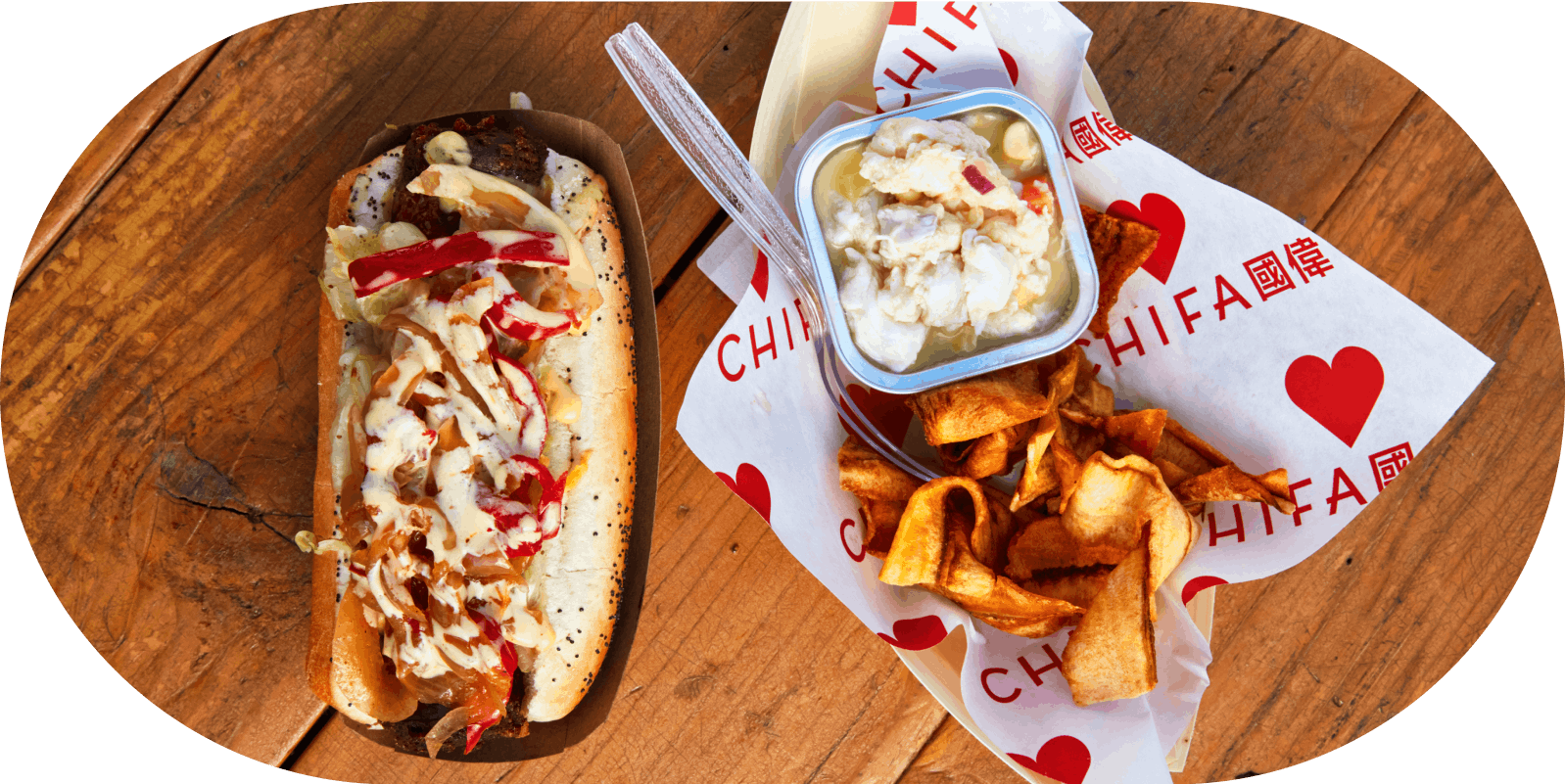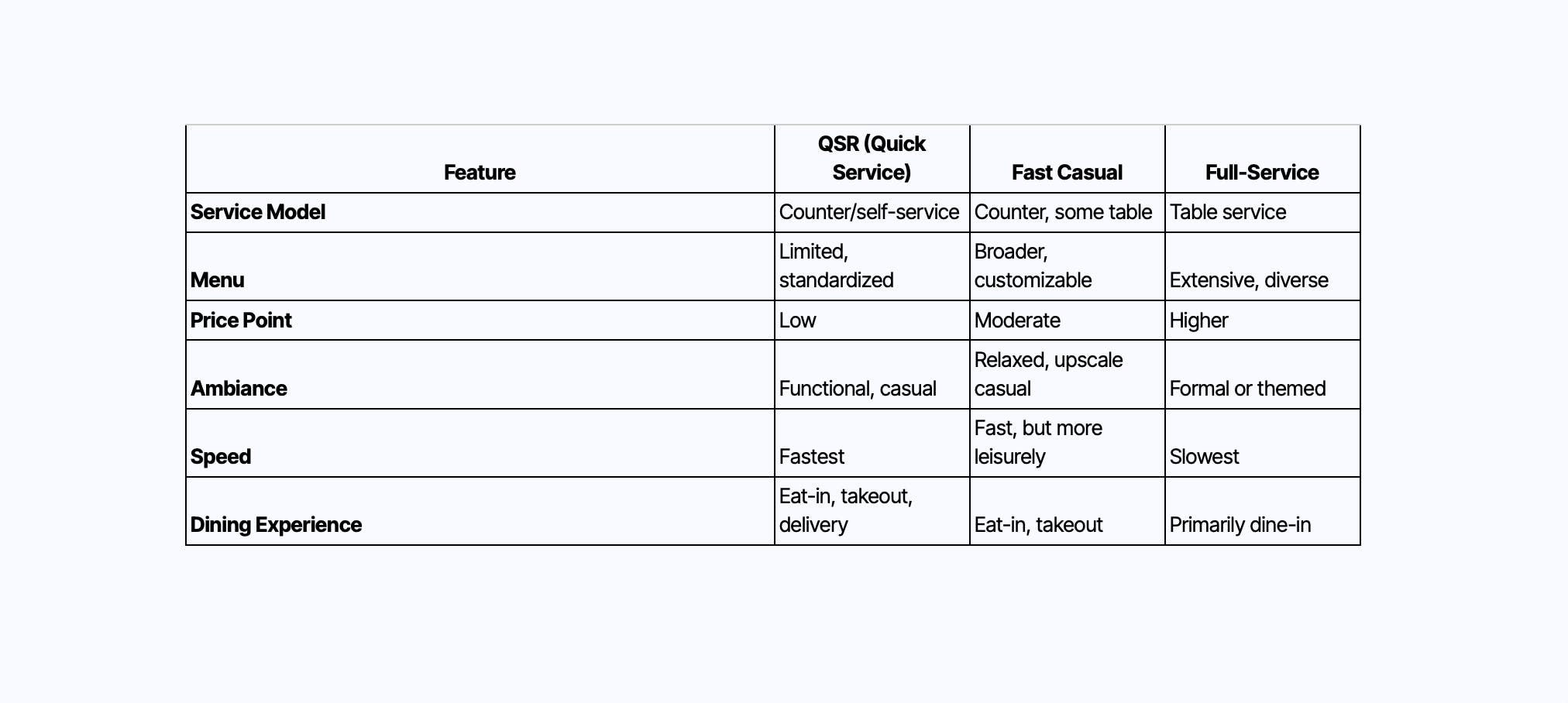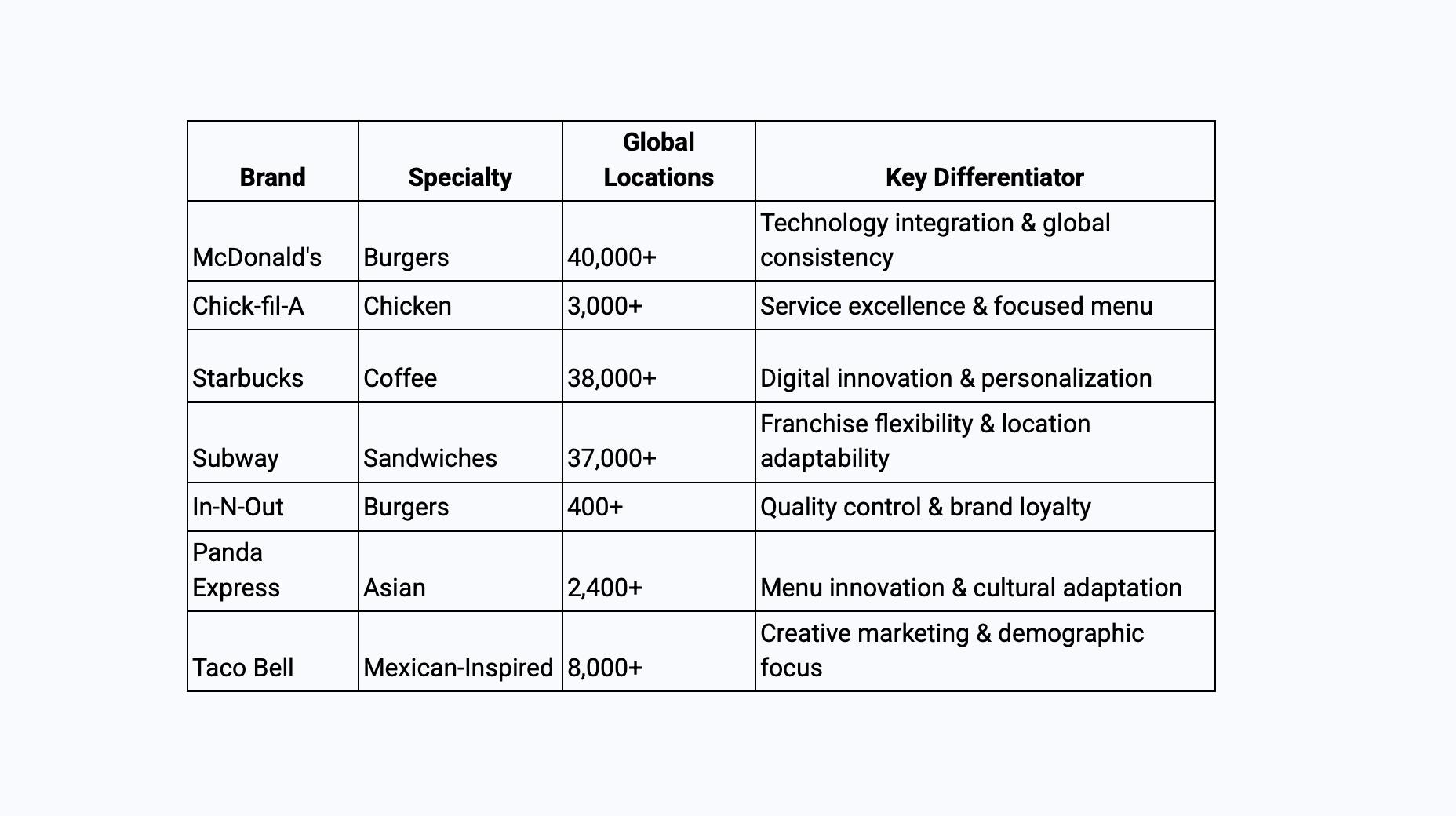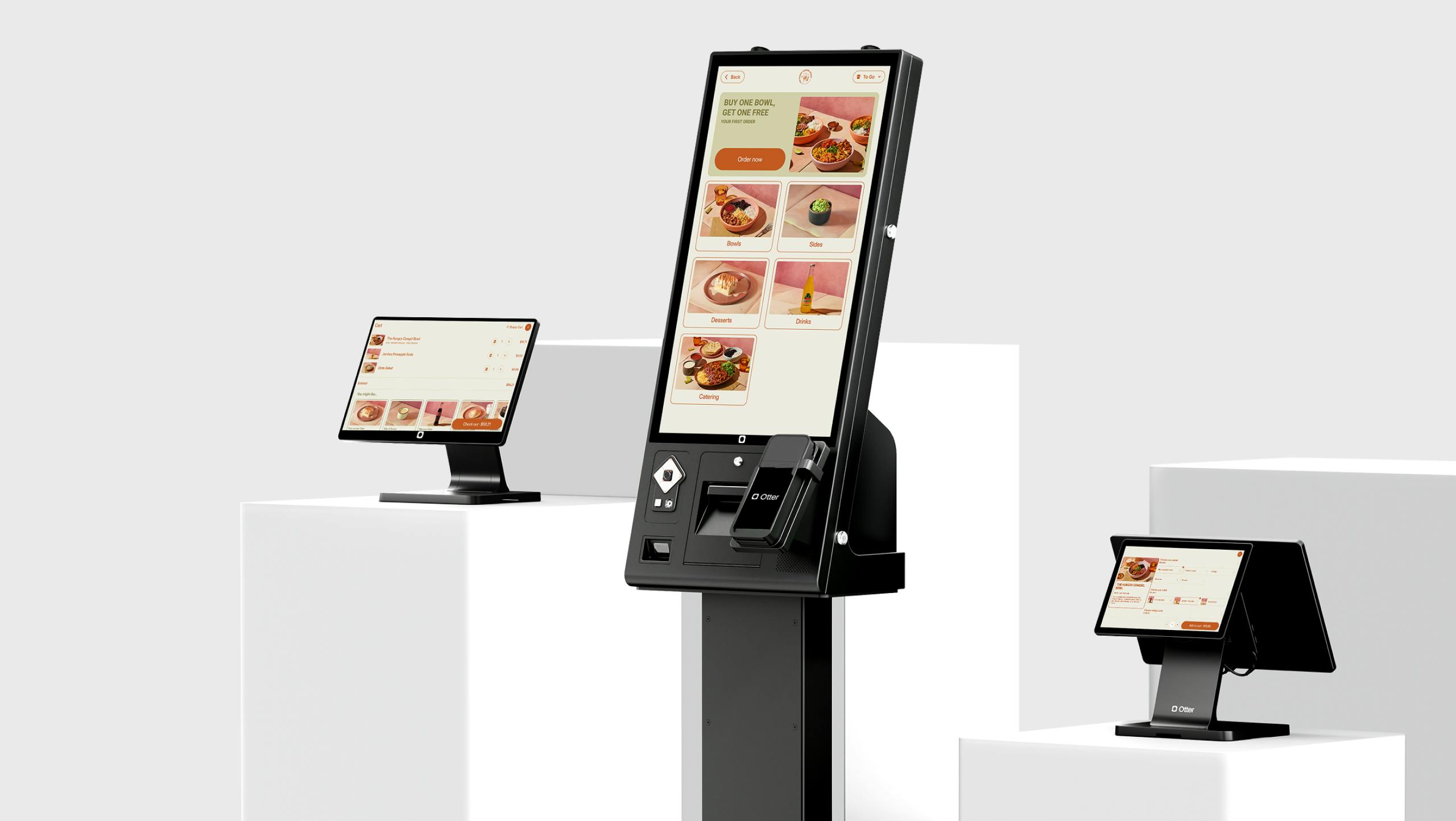
Table of contents
Every day, millions of customers walk into quick service restaurants expecting their order ready fast, exactly as ordered, at a price point that fits their budget. A quick service restaurant, also known as a QSR, is a dining establishment designed around speed of service, efficiency, and affordability. In these establishments, standardized menu items are optimized for takeout, delivery, or quick dine-in experiences. Unlike fast-casual restaurants, where establishments emphasize higher-quality ingredients and customization with some table service, QSRs focus on rapid counter service and consistent value, often through self-service models.
The QSR industry’s growth trajectory has been impressive. In the U.S. alone, the market was valued at nearly $249 billion in 2024 (1), with consumer demand for convenience, mobile ordering, and affordable meals driving continued expansion across global markets. From neighborhood burger joints to international coffee chains, QSRs are innovating through advanced drive-thru technology, mobile apps, and streamlined qsr operations, maximizing efficiency without sacrificing quality.
This guide explores what separates top-performing QSR chains from the competition, whether through operational excellence, standout branding, digital innovation, or exceptional customer experience. We'll analyze real-world examples, decode strategies behind success, and provide actionable insights for aspiring operators and franchisees. Whether you're planning your first location or scaling a multi-unit franchise concept, these practical takeaways will position your restaurant for growth in today's competitive quick service market.

What is a Quick Service Restaurant (QSR)?
Understanding the QSR meaning starts with recognizing that quick service restaurants, commonly known as fast food restaurants, represent a specific type of restaurant built around efficiency and accessibility. The QSR concept centers on serving affordable, efficiently prepared food items with minimal wait times and limited table service for dine in, take out, and delivery service customers.
Here’s how QSRs compare to other dining formats:

Common Traits of Successful QSRs
Counter service or self-service: Customers order at a counter, kiosks, or drive-thru, with minimal table service to maximize speed and throughput.
Limited menu, standardized food items: Fast food restaurants focus on a core set of popular menu items, allowing for fast preparation and consistent quality across all locations.
Speed and efficiency: QSRs are designed to serve high volumes of customers quickly, often relying on pre-prepared or rapidly assembled food items.
Affordability: Menu items are priced to be accessible, typically lower than those in fast-casual restaurants or full-service establishments.
Operational consistency: Standardized procedures and training ensure that customers receive the same dining experience at every location.
Why QSRs Are Scalable and Appealing for Operators
The QSR model's simplicity and efficiency make it highly attractive for franchise opportunities and multi-location growth. The standardized menu and streamlined operations enable rapid expansion while maintaining quality and customer satisfaction. This scalability offers several key advantages for restaurant management:
Lower operational complexity leads to faster staffing and training, plus easier management across locations. Predictable food costs through standardized portions and limited menu options help maintain consistent profitability. Technology integration becomes more manageable when systems and processes are uniform across all locations.
Modern quick service restaurants increasingly leverage technology platforms to enhance this scalability. Tools like Otter help operators streamline multichannel ordering systems, integrate delivery services platforms, and optimize kitchen workflows across their entire network. Centralized order management and real-time analytics enable operators to maintain efficiency and consistency as they grow.
For aspiring entrepreneurs, the QSR concept offers a proven path to restaurant business success: deliver consistent, convenient, and affordable meals at scale while leveraging technology to stay ahead of the competition.
Top Quick Service Restaurant Examples
The best way to understand what drives QSR success is by examining the industry leaders who've mastered it. From global fast food chains to regional favorites, these eateries demonstrate how focused strategies, operational excellence, and customer-centric innovation create lasting competitive advantages. Here are top quick service restaurant examples across various categories, showcasing what makes each restaurant chain exceptional and the actionable lessons they offer for aspiring operators:
1. McDonald's (Burgers, Global)
Overview: The world's largest QSR brand, McDonald's operates over 40,000 restaurants in more than 100 countries, primarily through franchise models.
What makes them stand out: Unmatched operational consistency and technology integration. McDonald's has perfected the art of standardization while embracing innovation, i.e. AI-powered drive-thru systems and dynamic digital menu boards. Their mobile app integration and data-driven decision-making set restaurant industry benchmarks for efficiency and customer experience.
Takeaway: Invest in technology infrastructure and standardized processes. Consistency at scale requires both rigorous systems and continuous innovation to stay ahead of QSR industry trends.
2. Chick-fil-A (Chicken Sandwiches, U.S.)
Overview: The largest fried chicken QSR in the U.S., Chick-fil-A operates over 3,000 locations with a unique franchise model that limits operators to a single location, ensuring focused restaurant management and quality control.
What makes them stand out: Industry-leading customer satisfaction through exceptional service culture and menu focus. Their "my pleasure" service standard, order accuracy rates of 92% (2), and streamlined menu create a premium QSR dining experience. Digital ordering now makes up almost 20% of Chick-fil-A's sales (3).
Takeaway: A limited menu combined with exceptional service standards can command premium pricing and drive customer loyalty that far exceeds industry averages.
3. Starbucks (Coffee, Global)
Overview: With over 38,000 stores worldwide, Starbucks blends QSR efficiency with café ambiance, using a mix of company-owned and licensed locations to adapt to local markets and dining options.
What makes them stand out: Digital innovation leadership and personalization at scale. Starbucks led the adoption of large-scale mobile ordering in the QSR space, with their mobile app generating 30% of transactions (4). Their loyalty program uses AI to deliver personalized recommendations, and their menu customization capabilities create a multitude of possible drink combinations.
Takeaway: Embrace digital-first customer experiences and use technology to enable mass customization without sacrificing speed of service or efficiency.
4. Subway (Sandwiches, Global)
Overview: One of the largest QSR chains by unit count with over 37,000 locations in 100+ countries, Subway's flexible franchise model enables expansion into non-traditional venues like gas stations, airports, and college campuses.
What makes them stand out: Adaptability and low-barrier franchise entry. Subway's assembly-line model allows for menu flexibility while maintaining operational simplicity. Their franchise system requires lower initial investment than most QSRs, making ownership accessible to first-time entrepreneurs.
Takeaway: Flexible operational models and adaptable locations can accelerate expansion into underserved markets and non-traditional venues.
5. In-N-Out Burger (Burgers, Regional U.S.)
Overview: Family-owned with 400+ locations exclusively in the western U.S., In-N-Out maintains company ownership of all locations and has built a cult following through controlled growth and quality focus.
What makes them stand out: Quality control through vertical integration and company ownership. In-N-Out operates their own distribution centers, maintains a simple menu, and pays above-industry wages to ensure consistency. Their "secret menu" creates customer engagement without menu complexity.
Takeaway: Controlled growth and quality focus can build stronger brand loyalty and higher per-unit sales than rapid expansion strategies.
6. Panda Express (Asian, U.S.)
Overview: The largest Asian QSR in the U.S., Panda Express operates over 2,400 locations primarily in the U.S., with recent expansion into international markets. Most locations are company-owned, enabling consistent quality control.
What makes them stand out: Menu innovation within operational constraints and cultural adaptation. Panda Express created American-Chinese fusion items like Orange Chicken while maintaining authentic wok cooking methods. Their kitchen design allows for made-to-order food preparation within QSR speed expectations.
Takeaway: Cultural menu adaptation and signature menu items can create new QSR categories while maintaining operational efficiency.
7. Taco Bell (Mexican-Inspired, Global)
Overview: With over 8,000 restaurants worldwide, Taco Bell leads in Mexican-inspired fast food through bold menu innovation, creative marketing, and strategic late-night positioning that captures unique dayparts in the fast food industry.
What makes them stand out: Menu creativity and demographic targeting. Taco Bell continuously introduces limited-time offers, collaborates with other brands (Doritos Locos Tacos), and targets younger demographics through social media marketing. Their late-night focus captures revenue during what would be off-peak hours for most fast food chains.
Takeaway: Bold menu innovation and strategic demographic targeting can differentiate your brand and capture untapped market segments.
Comparison Overview

Key Insights for QSR Success
The most successful quick service restaurant examples share common threads: they excel in their chosen focus area while maintaining operational efficiency. Whether it's McDonald's technology leadership, Chick-fil-A's service culture, or Starbucks' digital innovation, each restaurant chain has identified their core strength and built their entire operation around it.
For aspiring QSR operators, these examples demonstrate that success comes from choosing your competitive advantage—operational excellence, service quality, menu innovation, or market positioning—and executing it consistently across every location..
Operational Excellence: What Top QSRs Do Differently
Top-performing quick service restaurants succeed through disciplined operational excellence. While every QSR concept is different, the most successful fast food chains share common approaches to standardization, staffing, supply chain optimization, and technology integration that enable them to scale while maintaining brand standards.
Key Elements of QSR Operational Excellence
Staffing and training models
Leading QSRs prioritize hiring for attitude and cultural fit, then invest in comprehensive training programs that emphasize technical skills and customer service. Most successful QSR operations use structured onboarding processes that combine hands-on training with digital learning modules.
Cross-training is essential in QSR operations, enabling team members to handle multiple roles during peak periods or staffing shortages. This flexibility helps maintain speed of service and reduces operational disruptions that can impact the customer experience.
Standardized Operating Procedures (SOPs)
Standard Operating Procedures form the backbone of QSR consistency. Successful QSR chains document every aspect of operations, including food preparation timing and portion control to customer greeting protocols and cleaning schedules. These detailed SOPs ensure that customers receive the same dining experience regardless of location or time of day.
Menu standardization is particularly critical, as it allows for predictable preparation times, consistent food costs, and reliable quality. QSRs that excel operationally typically maintain a limited menu to maintain speed and reduce training requirements.
Franchise vs. corporate structure considerations
QSR operators must choose between franchise opportunities for rapid expansion or maintaining company ownership for tighter control. Each model offers distinct operational advantages: franchise models enable faster growth with local market knowledge, while corporate ownership provides greater consistency and brand control.
A comprehensive study covering over 3,000 franchised and company-owned stores found that franchised units consistently outperform company-owned units, with franchised locations showing 5-15% better revenue performance and 10% lower labor costs (5). However, well-managed company-owned stores can match franchise performance when they receive strong support and operate in prime locations. The optimal approach often combines both models to leverage the growth advantages of franchising while maintaining corporate locations for brand standards and testing.
Supply chain and inventory management
Efficient supply chain management directly impacts both food costs and quality consistency. Successful QSRs typically work with centralized distribution systems and maintain strict vendor standards.
Inventory management in QSRs requires balancing freshness with waste reduction. Most high-performing QSR operations use predictive ordering systems and just-in-time delivery to minimize food waste while ensuring adequate stock levels during peak periods.
Technology's role in QSR operations
Modern QSR operations rely heavily on technology integration to standardize processes, reduce human error, and provide real-time visibility into operations.
Centralized management systems
Multi-location QSR operators benefit from centralized systems that provide oversight across all stores. These platforms typically include real-time sales monitoring, inventory tracking, and performance analytics that help operators identify and address issues quickly.
Order management integration
QSR operations today must manage orders from multiple channels: dine-in, online ordering, delivery services, and drive-thru. Integrated ordering systems help consolidate these various order streams into kitchen workflow, reducing complexity and minimizing errors.
Tools like Otter's order management platform help QSR operators streamline this multichannel complexity by routing all orders through a single POS system, regardless of their source. This consolidation reduces manual entry errors and helps maintain consistent fulfillment times.
Performance analytics and reporting
Data-driven decision making is essential for QSR operational excellence. Most successful QSR operations identify areas for improvement by tracking order accuracy, fulfillment times, customer satisfaction scores, and food costs.
Order fulfillment time is particularly critical, as the restaurant industry standard is 2-3 minutes per order. Exceeding 3 minutes can lead to a 10-15% decline in customer satisfaction rates (6), making speed monitoring essential for maintaining competitive service levels.
Quality Control and Cost Management
Food safety and quality standards
QSR operations must maintain strict food safety protocols while serving high volumes quickly. This requires systematic approaches to temperature monitoring, storage procedures, and food preparation timing. Regular auditing and documentation help ensure compliance and uniformity.
Cost control strategies
Successful QSR operations typically focus on controlling their largest cost categories: food costs, labor costs, and overhead. This includes portion control systems, labor scheduling optimization, and energy-efficient equipment to stay profitable while delivering value.
Takeaways for QSR operators
Operational excellence in quick service restaurants comes from building scalable systems that prioritize consistency, efficiency, and quality. The most successful operators focus on creating detailed procedures, investing in staffing and training, leveraging technology for standardization, and maintaining strict quality control measures.
For aspiring QSR operators, the key is to establish these operational foundations early, even with a single location. Building strong systems from the start makes scaling much more manageable and helps maintain brand standards as you grow. Technology platforms that integrate order management, analytics, and multi-location oversight become essential tools for operators planning expansion beyond their initial location.

Digital Innovation in QSRs (and Why It Matters)
Digital innovation has become essential for QSR success, fundamentally changing how fast food chains attract, serve, and retain their customer base. Leading quick service restaurants leverage technology not just for convenience, but to deliver faster, more personalized experiences while optimizing operations and gathering valuable customer data.
Essential Digital Features Driving QSR Success
Mobile ordering & loyalty apps
Mobile ordering allows customers to browse menu options, customize orders, and pay ahead. QSRs benefit from higher average order values and detailed customer data that enables targeted marketing and menu optimization.
Loyalty programs integrated with mobile apps create powerful engagement tools. Starbucks pioneered this approach with their rewards program, demonstrating how digital loyalty can drive frequent visits and customer retention. Nearly 3 in 5 (58%) Starbucks customers regularly use the mobile app (7).
Self-service kiosks
Self-service kiosks help QSRs reduce wait times, increase order capacity, and minimize order errors. Customers can browse full menu options at their own pace, while restaurants benefit from faster throughput and reduced labor costs during peak periods. McDonald's and Panera Bread have led kiosk adoption, showing measurable improvements in order accuracy and customer satisfaction.
Third-party delivery platform integration
Delivery services have become a major revenue channel for QSRs, with third-party platforms providing access to customers who prefer off-premise dining options. The global third-party delivery market was valued at $87.6 billion in 2024 and is projected to reach $197.1 billion by 2033 (8). However, managing multiple delivery services can create operational complexity without proper integration systems.
QR code ordering & contactless payment
QR code technology enables contactless ordering experiences, allowing customers to scan codes to view digital menus, place orders, and pay from their phones. This technology reduces staffing intervention, speeds up service, and provides real-time menu updates.
How Leading QSRs Implement Digital Innovation
McDonald's has integrated digital menu boards, self-service kiosks, and mobile ordering across thousands of locations. Their digital investments enable dynamic pricing, real-time promotions, and menu customization based on location and time of day.
Starbucks built industry-leading mobile ordering and loyalty integration, with their mobile app serving as a model for digital customer engagement. Their ordering system combines ordering, payment, and rewards in a seamless experience.
Panera implemented QR-table ordering that lets guests scan, order, and pay from their table, improving dine-in operations and table turnover rates while offering diverse dining options.
How Technology Platforms Enable QSR Digital Success
Modern quick service restaurants require integrated technology solutions to manage the complexity of multiple digital channels effectively.
Omnichannel order management
Successful QSR digital strategies consolidate orders from all channels—delivery services, mobile apps, kiosks, and dine-in—into unified workflows. Otter's POS system exemplifies this approach by aggregating orders from major delivery platforms and direct channels into a single dashboard, reducing manual entry and streamlining kitchen operations.
QR ordering solutions
QR ordering technology enables restaurants to offer contactless dine-in experiences without significant infrastructure investment. Otter's QR ordering product allows customers to browse, order, and pay from their phones while orders sync instantly with POS and kitchen systems.
Customer data and analytics
Digital platforms provide valuable insights into customer behavior, order patterns, and menu performance. Otter's analytics dashboard helps operators track customer engagement, identify popular food items, and optimize menu offerings based on real ordering data.
Why Digital Innovation Matters for QSR Operators
Digital technology addresses core QSR challenges: speed of service, accuracy, and scalability. Mobile ordering reduces peak-hour congestion, self-service options increase order capacity, and integrated systems ensure consistency, despite the location.
For multi-location operators, digital tools become essential for maintaining operational control and brand standards. Centralized menu management, real-time performance monitoring, and unified customer data help operators make informed decisions and respond quickly to market changes.
The QSRs that succeed in today's competitive fast food industry combine multiple digital touchpoints into cohesive customer experiences. This integration requires technology platforms that can unify various systems and channels while providing the operational insights needed to optimize performance and drive growth.
Otter: The Tech Toolkit That Enables QSR Success
As we've seen throughout this guide, successful quick service restaurants share common traits: operational consistency, digital innovation, and the ability to scale efficiently while maintaining quality. Otter serves as the unified technology platform that helps QSR operators achieve these goals.
How Otter Addresses Core QSR Challenges
Streamlines multi-channel complexity
Modern QSR operations must manage orders from numerous sources: delivery services, mobile ordering, in-store kiosks, and walk-in customers. Otter consolidates all these channels into a single dashboard, eliminating the need to juggle multiple tablets and systems, allowing staff to focus on food quality and customer experience rather than technology management.
Enables consistent multi-location management
For operators running multiple locations, maintaining consistency becomes exponentially more challenging. Otter's centralized platform provides real-time oversight across all stores, so operators can update menu items, monitor performance, and identify issues instantly from one interface
Delivers actionable business intelligence
Otter's analytics dashboard transforms raw order data into actionable insights. Operators can do everything from track sales trends to analyze customer behavior patterns, leading to informed decisions about menu optimization, staffing, and marketing to improve profitability.
Integrates seamlessly with existing systems
Otter is designed to work alongside your current technology, connecting with a wide range of POS systems and third-party restaurant services. It consolidates online and offline orders into a single system, sending orders directly from any channel to your POS and then straight to the kitchen.
Key Solutions for QSR Growth
Order management: Unifies all ordering systems while maintaining kitchen efficiency and reducing manual entry errors.
OtterPOS: Provides integrated point-of-sale capabilities designed specifically for multi-channel QSR operations.
QR ordering: Enables contactless dine-in experiences without requiring significant infrastructure investment.
Analytics platform: Delivers real-time insights into performance, customer behavior, and operational efficiency.
Frequently Asked Questions
- How does Otter support rapid QSR expansion? Otter's standardized platform makes adding new locations straightforward. Menu updates, pricing changes, and operational procedures can be deployed instantly across all stores, while centralized reporting provides immediate visibility into new location performance.
- What's the integration process like? Otter connects with your existing POS system and kitchen systems, typically requiring minimal downtime. The platform is designed to work with your current operations rather than requiring complete system replacement.
- How does Otter help improve profit margins? By reducing order errors, streamlining operations, and providing detailed cost analysis, Otter helps operators identify revenue opportunities and operational inefficiencies. Mr. Pickle's Sandwich Shop used Otter's Revenue Recapture and Analytics solutions to automatically recover lost revenue from delivery disputes while gaining insights that improved their overall delivery operations efficiency (9).
Taking the Next Step
The QSR landscape continues to evolve rapidly, with customer expectations for speed of service, convenience, and consistency only increasing. Success means operational excellence, digital innovation, and the ability to scale efficiently.
Otter provides the technological foundation that enables QSR operators to meet these challenges while focusing on what matters most: delivering exceptional food and customer experiences. Whether you're planning your first location or managing multiple stores, having the right technology partner can make the difference between surviving and thriving in the competitive quick service restaurant industry.

Book a demo with Otter
It’s time to enhance your operations with Otter’s all-in-one restaurant platform. Book time with our sales team to learn more.

Book a demo to see how Otter’s all-in-one platform can help your restaurant thrive.